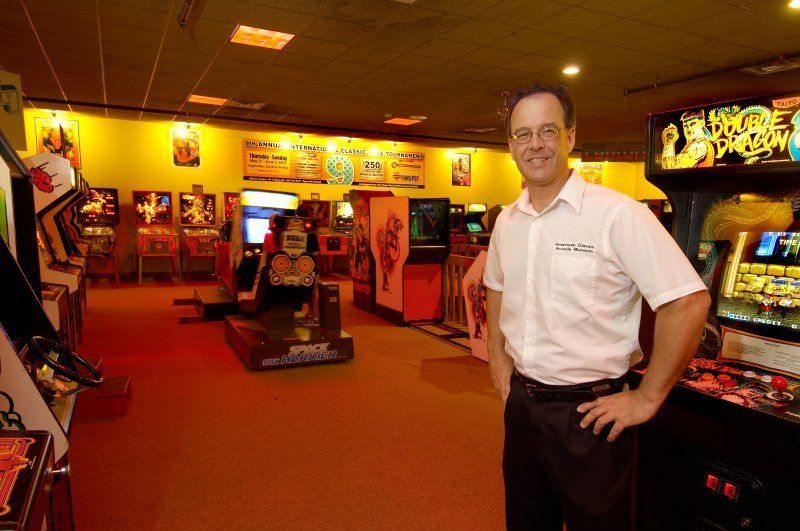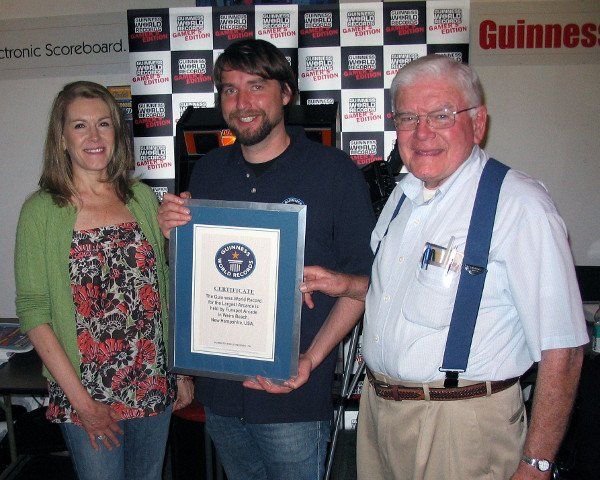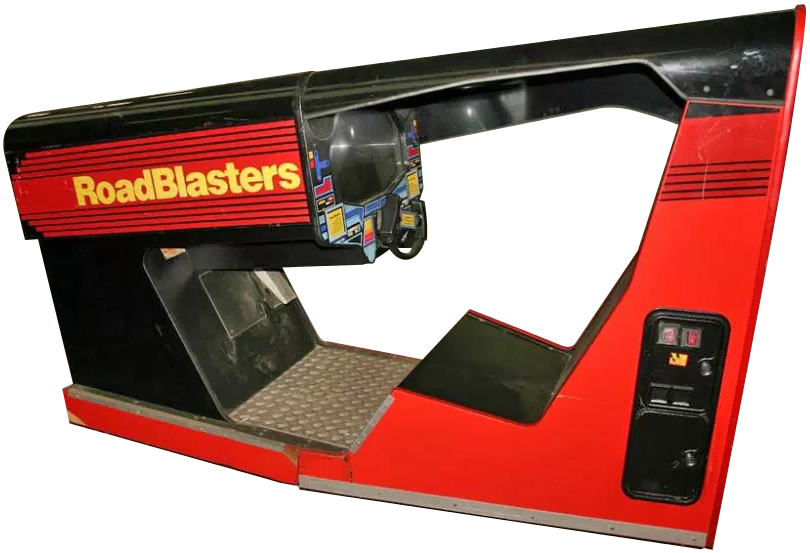Arcade Museum Celebrates 1980s
RoadsideAmerica.com • May 22, 2010

Who could have guessed that putting 250 ancient video arcade mechanisms in one place would open a temporal wormhole for aging gamers to relive their wasted youth? That's the American Classic Arcade Museum.
Calling it a museum is not quite right. While it does have exhibit cases of gaming artifacts and memorabilia along the outer walls -- we were particularly impressed by the Pac-Man Halloween costume display -- it's mostly an actual, operating arcade.
That makes it even better.
Not that the American Classic Arcade Museum doesn't have potential pitfalls. It could become just another place where the formerly young elevate their days-of-yore at the expense of the days-of-now. But while we were there, we didn't hear anyone waxing poetic about the purity of 2-D graphics or the ambiance of computer chip music.
Old video arcade games didn't have the technology to be pretentious. They had to be simple and fun. Driving a tank around a glowing green wire-frame pyramid in Battlezone (1980) is no less engaging than crawling your way through hyper-real Stalingrad in Call Of Duty (2003), although you might have difficulty convincing a 25-year-old of that.
Still, for a generation that's only played Tetris and Space Invaders on a cell phone, this place could be enlightening.
It's Official!
Bob Lawton and daughter, Sandra, accept the Guinness World Record for Largest Arcade In The World.
The museum currently operates over 250 machines on the game floor. There are many more in storage, and it's just one part of the much larger Funspot complex, certified by Guinness as the largest arcade in the world.
Bob Lawton was born in 1931 and co-founded Funspot in 1952. He's still here, every day, and he still plays; his favorite machines are Rally-X -- one of the earliest full-color games -- and KISS pinball. So does Gary Vincent, who oversees the museum.
Gary came to work at Funspot as a teenager in 1981 and never left. He's proud of the museum, and especially proud that it's a working Golden Age video arcade. "You can stand here and close your eyes and listen," he said, "and it's 1983 all over again."
A constant stream of Pat Benatar, Duran Duran, and other early 1980s pop mainstays plays over loudspeakers, although Gary admits that he doesn't crank it up to 1980s arcade volume ("It's like Disney," he concedes. "Real but not real."). But the clanking of quarters (well, tokens) spilling from the change machine is real enough, as are the goofy, overlapping sound effects from hundreds of machines: the base-heavy uh-eh uh-eh uh-eh of Space Invaders, the gowah gowah gowah of a gobbling Pac-Man, the Bee-ee-ee-ee-you! death dirge from Frogger.
To some, it sounds like heaven.
"It's surprising how many people play," said Bob. "They'll bring their own stools and they'll sit and they'll play, day after day. Sometimes you just can't move in here. It's amazing."
"Once," Gary recalled, "I overheard one guy say to another guy's kid, 'When your dad was your age he kicked ass on this game!'"
Row after row of upright cabinets beckon, with iconic ball-topped joysticks and cookie-size buttons on the control panels, and glowing coin slots on the front. Some of the machines are scuffed and stained, and not all of the games are working at any one time -- which also evokes the 1980s arcade experience. But most of the games are in good shape, ready to satisfy. We saw a hapless, foot-dragging summer employee shuffling around, emptying the coin boxes, and found it surprisingly nostalgic.
Along the way, Bob and Gary have had to relearn some forgotten video arcade tricks, such as covering the fluorescent light fixtures with red gel to darken the rooms. "If you don't," said Gary, "the screens look just terrible."
Behind the Red Baron and Roadblasters machines is the Classic Game Wall of Fame, enshrining players who have set world records at the museum's annual tournaments. Champions such as Donald Hayes (248,100 points on Super Cobra) and David Nelson (61,390 on Clowns) are among dozens of honorees. Each has a framed photo of themselves standing next to the machine that made him immortal.
Blast from the Past:
Try finding one of these anywhere else — let alone one you can play. It's a genuine Road Blasters cockpit arcade game at the American Classic Arcade Museum.
Funspot is where Steve Wiebe scored almost a million points on Donkey Kong during the documentary The King of Kong. That machine, according to Gary, has become a Holy Grail among video arcade enthusiasts. "There's a core group of guys," he said, "that are bound and determined to crack that machine."
Bob and Gary show us some of the museum's oldest members, such as the glittery Computer Space from 1971, the first video arcade game (its monitor is actually an old black and white TV set, powered by vacuum tubes) and the ghoulish Death Race from 1976, which earned a spot on a "violent video games" 60 Minutes segment. "Bob and I are very proud of our Death Race," said Gary. "You kill people," added Bob, wide-eyed. "And they scream!"
Visitors not only get to see and touch games like Death Race, but play them as well. Rarities such as Up Scope and a triple-screen TX-1 invite the itchy-fingered, as does the possibly unique Whatizit from 1972, which forgoes video for a loop of battered 16mm film. There are hard-to-find color vector games such as Tempest and Star Wars, and impossible-to-find functioning Laser Disk games such as Astron Belt and the creepy Us Vs. Them.
The laser games arrived in 1983 and, according to Gary, usually failed after about three months of arcade use. Eventually there were no more spare parts to fix them. The museum has solved that problem by running its laser disk machines on PC emulators tucked inside the cabinets. "The games play probably 99 percent identical, but a thousand times more reliable," said Gary. "People can enjoy them again without seeing Disk Error on the screen."
Bob and Gary agree that the "classic" period of video arcade games ended in 1986, and so do most of the machines in the museum. The ability to keep these aging games running is what sets the museum apart from wannabe competitors. Funspot has its own repair shop, plenty of room, and a staff that's been working with these machines since they first arrived over 30 years ago.
"We just feel it's very important to save these games, and to have them playable," said Bob. "Nobody else has done that, and I don't think anybody else is gonna do that."
"The biggest thrill that we get," said Gary, "is when those first-time visitors come in the door and go, 'Wow!' When you can get a 'Wow' and then nothing else except a big, giant grin out of people, then you know you're doing something right."



